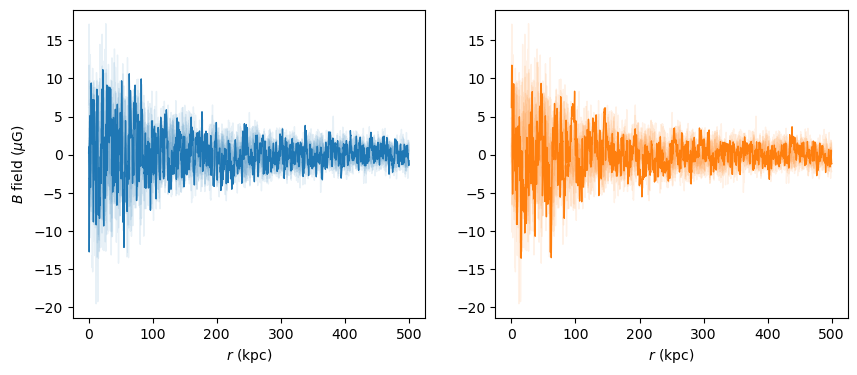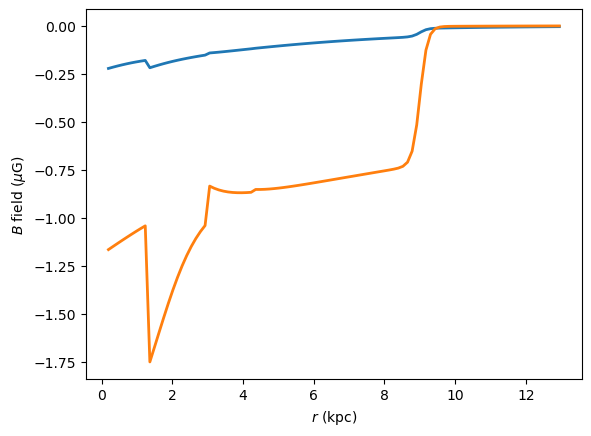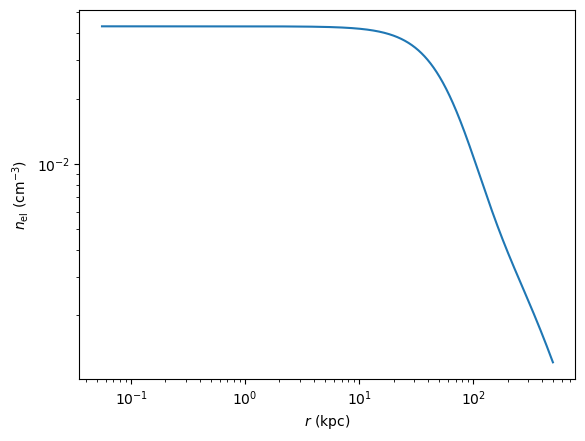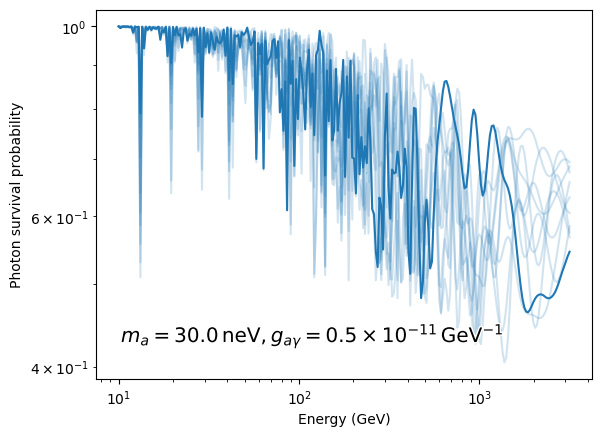Mixing in Gaussian turbulence field: Perseus cluster and from NGC 1275
This tutorial demonstrates how to calculate the photon-ALP transition probability in a magnetic field with Gaussian turbulence on the example of the Perseus cluster with the central radio galaxy NGC 1275. The assumed B-field environments are the same as in Ajello et al. (2016) and include the cluster field and the magnetic field of the Milky Way.
If you haven’t installed gammaALPs already, you can do so using pip. Just uncomment the line below:
[1]:
#!pip install gammaALPs
We start of with the usual imports:
[2]:
from gammaALPs.core import Source, ALP, ModuleList
from gammaALPs.base import environs, transfer
import numpy as np
import matplotlib.pyplot as plt
from matplotlib.patheffects import withStroke
from ebltable.tau_from_model import OptDepth
from astropy import constants as c
And initialize an ALP object, which stores the ALP mass \(m_a\) (in neV) and the coupling \(g_{a\gamma}\) (in \(10^{-11}\mathrm{GeV}^{-1}\)).
[3]:
m, g = 1.,1.
alp = ALP(m,g)
Next, we set the source properties (redshift and sky coordinates) in the Source container. These can be taken form your favorite catalot for extragalactic objects, e.g., NED.
[4]:
ngc1275 = Source(z=0.017559, ra='03h19m48.1s', dec='+41d30m42s')
print (ngc1275.z)
print (ngc1275.ra, ngc1275.dec)
print (ngc1275.l, ngc1275.b)
0.017559
49.950416666666655 41.51166666666666
150.57567432060083 -13.261343544296324
Init the module list
Next, we can initialize the list of transfer modules that will store the different magnetic field environments. First, we provide the energies for which we would like to compute the conversion probability
[5]:
EGeV = np.logspace(1., 3.5, 250)
Now initialize the initial photon polarization. Since we are dealing with a gamma-ray source, no ALPs are initially present in the beam (third diagonal element is zero). The polarization density matrix is normalized such that its trace is equal to one, \(\mathrm{Tr}(\rho_\mathrm{in}) = 1\).
[6]:
pin = np.diag((1.,1.,0.)) * 0.5
The module list is initialized with our choices for the ALP, our source, the initial polarization, and the energies at which we compute the photon-ALP mixing
[7]:
ml = ModuleList(alp, ngc1275, pin = pin, EGeV = EGeV)
Now we add propagation modules for the cluster, the EBL, and the Galactic magnetic field. By setting nsim=10 we calculate 10 random realizations of the magnetic field.
[8]:
ml.add_propagation("ICMGaussTurb",
0, # position of module counted from the source.
nsim=10, # number of random B-field realizations
B0=10., # rms of B field in muG
n0=3.9e-2, # normalization of electron density in cm-3
n2=4.05e-3, # second normalization of electron density, see Churazov et al. 2003, Eq. 4 on cm-3
r_abell=500., # extension of the cluster in kpc
r_core=80., # electron density parameter, see Churazov et al. 2003, Eq. 4 in kpc
r_core2=280., # electron density parameter, see Churazov et al. 2003, Eq. 4 in kpc
beta=1.2, # electron density parameter, see Churazov et al. 2003, Eq. 4
beta2=0.58, # electron density parameter, see Churazov et al. 2003, Eq. 4
eta=0.5, # scaling of B-field with electron denstiy
kL=0.18, # maximum turbulence scale in kpc^-1, taken from A2199 cool-core cluster, see Vacca et al. 2012
kH=9., # minimum turbulence scale, taken from A2199 cool-core cluster, see Vacca et al. 2012
q=-2.80, # turbulence spectral index, taken from A2199 cool-core cluster, see Vacca et al. 2012
seed=0 # random seed for reproducability, set to None for random seed.
)
ml.add_propagation("EBL",1, eblmodel='dominguez') # EBL attenuation comes second, after beam has left cluster
ml.add_propagation("GMF",2, model='jansson12') # finally, the beam enters the Milky Way Field
environs.py: 431 --- INFO: Using inputted chi
environs.py:1196 --- INFO: Using inputted chi
List the module names:
[9]:
print(ml.modules.keys())
['MixICMGaussTurb', 'OptDepth', 'MixGMF']
We can also change the ALP parameters before running the modules:
[10]:
ml.alp.m = 30.
ml.alp.g = 0.5
We can also inspect the magnetic-field realization and electron density along the line of sight. The magnetic-field realizations are stored in ml.modules["ICMGaussTurb"].Bn,
[11]:
print (ml.modules["ICMGaussTurb"].Bn.shape)
(10, 4499)
And multiplying the magnetic field with the \(\psi\) angles stored in ml.modules["ICMGaussTurb"].Psin will give us the two components transversal to the propagation direction:
[12]:
fig = plt.figure(figsize=(10,4))
ax1 = fig.add_subplot(121)
ax2 = fig.add_subplot(122)
for i, B in enumerate(ml.modules["ICMGaussTurb"].Bn):
ax1.plot(ml.modules["ICMGaussTurb"].r,
B * np.sin(ml.modules["ICMGaussTurb"].psin[i]),
lw=1,
alpha=1 if not i else 0.1,
color=plt.cm.tab10(0.)
)
ax2.plot(ml.modules["ICMGaussTurb"].r,
B * np.cos(ml.modules["ICMGaussTurb"].psin[i]),
lw=1,
alpha=1 if not i else 0.1,
color=plt.cm.tab10(0.1)
)
ax1.set_ylabel('$B$ field ($\mu$G)')
ax1.set_xlabel('$r$ (kpc)')
ax2.set_xlabel('$r$ (kpc)')
[12]:
Text(0.5, 0, '$r$ (kpc)')

The coherent magnetic field in the Milky Way used in the mixing can be plotted in a similar way. Note that we’re using the attributes ml.modules["GMF"].B and ml.modules["GMF"].psi since we are dealing with one coherent magnetic field and not many random realizations.
[13]:
plt.plot(ml.modules["GMF"].r, ml.modules["GMF"].B * np.sin(ml.modules["GMF"].psi),
lw=2)
plt.plot(ml.modules["GMF"].r, ml.modules["GMF"].B * np.cos(ml.modules["GMF"].psi),
lw=2)
plt.ylabel('$B$ field ($\mu$G)')
plt.xlabel('$r$ (kpc)')
[13]:
Text(0.5, 0, '$r$ (kpc)')

The electron density in our Perseus cluster model looks like this
[14]:
plt.loglog(ml.modules["ICMGaussTurb"].r, ml.modules["ICMGaussTurb"].nel)
plt.ylabel('$n_\mathrm{el}$ (cm$^{-3}$)')
plt.xlabel('$r$ (kpc)')
[14]:
Text(0.5, 0, '$r$ (kpc)')

Run all modules
Now we run the modules. If multiprocess key word is larger than two, this will be split the calculation of the oscillation probability for the random realizations onto multiple cores with python’s multiprocess module.
The px, py, pa variables contain the mixing probability into the two photon polarization states (\(x\), \(y\)) and into the axion state (\(a\)).
[15]:
px, py, pa = ml.run(multiprocess=4)
core.py: 658 --- INFO: Running Module 0: <class 'gammaALPs.base.environs.MixICMGaussTurb'>
core.py: 658 --- INFO: Running Module 2: <class 'gammaALPs.base.environs.MixGMF'>
/Users/mey/Python/gammaALPs/gammaALPs/base/transfer.py:799: UserWarning: Not all values of linear polarization are real values!
warnings.warn("Not all values of linear polarization are real values!")
/Users/mey/Python/gammaALPs/gammaALPs/base/transfer.py:802: UserWarning: Not all values of circular polarization are real values!
warnings.warn("Not all values of circular polarization are real values!")
Plot the output
Finally, we now plot the resulting total survival probability, \(P_{\gamma\gamma} = P_x + P_y\) for each magnetic-field realization.
[16]:
pgg = px + py # the total photon survival probability
effect = dict(path_effects=[withStroke(foreground="w", linewidth=2)])
for i, p in enumerate(pgg): # plot all realizations
plt.loglog(ml.EGeV, p, color=plt.cm.tab10(0.), alpha=1 if not i else 0.2)
plt.xlabel('Energy (GeV)')
plt.ylabel('Photon survival probability')
plt.annotate(r'$m_a = {0:.1f}\,\mathrm{{neV}}, g_{{a\gamma}}'
r' = {1:.1f} \times 10^{{-11}}\,\mathrm{{GeV}}^{{-1}}$'.format(ml.alp.m, ml.alp.g),
xy=(0.05,0.1),
size ='x-large',
xycoords='axes fraction',
**effect)
[16]:
Text(0.05, 0.1, '$m_a = 30.0\\,\\mathrm{neV}, g_{a\\gamma} = 0.5 \\times 10^{-11}\\,\\mathrm{GeV}^{-1}$')

[ ]: